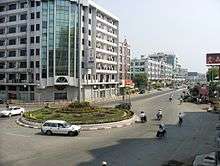Chinese people in Myanmar
Burmese Chinese, also Sino-Burmese or Tayoke, are a group of overseas Chinese born or raised in Myanmar (Burma). Burmese Chinese constitute one group of overseas Chinese and is relatively small compared to other overseas Chinese communities in Southeast Asia. Although the Chinese officially make up three percent of the population, the actual figure is believed to be much higher. Among the under-counted Chinese populations are: those of mixed background;[3] those that have registered themselves as “ethnic Bamar” to avoid discrimination; those that moved to Myanmar from China during earlier Qing Dynasty because of Manchu rule; new Chinese immigrants and traders that have resided in Upper Myanmar since the 1990s (up to 2 million by some estimates[4]) but are not counted due to the lack of reliable census taking.[5] As of 2012, the Burmese Chinese population is estimated to be at 1.6 million.[1][2]
| Total population | |
|---|---|
| 1,637,540 3.0% of the Burmese population (2012)[1][2] | |
| Regions with significant populations | |
| Yangon, Mandalay, Kokang, Taunggyi | |
| Languages | |
| Burmese, Varieties of Chinese (Hokkien, Hakka, Cantonese, Southwestern Mandarin, Mandarin ) | |
| Religion | |
| Theravada Buddhism, Mahayana Buddhism Taoism, Confucianism, Christianity, Islam among Panthay Hui | |
| Related ethnic groups | |
| Kokang, Panthay and other overseas Chinese communities |
| Chinese people in Myanmar | |||||||||||
|---|---|---|---|---|---|---|---|---|---|---|---|
| Traditional Chinese | 緬甸華人 | ||||||||||
| Simplified Chinese | 缅甸华人 | ||||||||||
| |||||||||||
| Alternative Chinese name | |||||||||||
| Traditional Chinese | 緬甸華僑 | ||||||||||
| Simplified Chinese | 缅甸华侨 | ||||||||||
| |||||||||||
Burmese Chinese are a well established middle class ethnic group and are well represented in all levels of Burmese society.[6] Burmese Chinese also play a leading role in Myanmar's business sector and dominate the Burmese economy today. [7][8][9][10][11][12] In addition, Burmese Chinese have a strong presence in Myanmar's political scene with several people such as Kyaing Kyaing, Khin Nyunt, Ne Win, and San Yu having been major political figures.[13][14][15]
Etymology
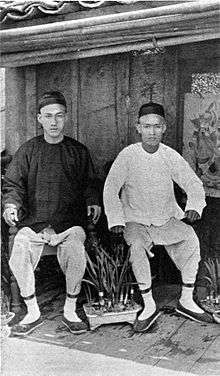
In the Burmese language, the Chinese are called Tayoke (တရုတ်, tarut), pronounced [təjoʊʔ], and formerly spelt တရုပ် (tarup). The earliest evidence of this term dates to the Bagan era, in the 13th century, during which it referred to the territory and a variety of peoples to the north and northeast of Myanmar. Various scholars have proposed that it comes from the Chinese term for "Turk" (突厥, Tūjué / tú jué[16]); from the name of Dali (大理國, Dàlǐguó), the capital of the Kingdom of Nanzhao; a Chinese corruption of the term Dàyuèzhī (大月支 or 大月氏), a Chinese term referring to Mongol-speaking Kushan Huns.[17] The adoption of Tayoke to refer to the Han Chinese was not an established practice until the 19th century.[17]
In the Mon language, the Chinese are known as Krawk (ကြုက်, /krɜk/);[18] in Shan, they are called Khe (ၶႄႇ, /kʰɛ˨/).[19] In the Wa language, spoken in the borderlands between Yunnan Province and Shan State, the word for Chinese is Hox/Hawx, pronounced /hɔʔ/.
Ancestral origins
The area around Yangon and Lower Myanmar was traditionally populated with Han Chinese from Fujian and Guangdong, whereas the areas around Mandalay and Upper Myanmar such as Kokang were traditionally populated with Han Chinese from Yunnan.
The Hokkiens and Cantonese comprised 45% of the ethnic Chinese population.[20][21] The Yunnanese comprised 30-40% of the ethnic Chinese population.[22]
Hokkien
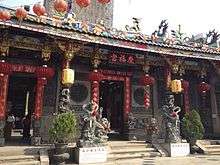
- Hokkien Chinese (Burmese: eingyi shay အင်္ကျီရှည်, or let shay လက်ရှည် lit. long-sleeved jackets) from Fujian Province. Most of the Hokkien were traders.
Cantonese
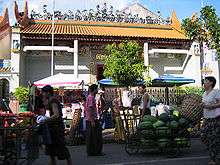
- Cantonese Chinese (Burmese: eingyi to အင်္ကျီတို, or let to လက်တို lit. short-sleeved jackets) from central Guangdong Province. Most migrants from Guangdong Province were artisans.
Hakka
- Hakka Chinese (Burmese: zaka စက, lit. mid-length sleeve) from Fujian and Guangdong provinces
Hakkas are further subdivided into those with ancestry from Fujian Province and Guangdong Province, called eingyi shay haka (အင်္ကျီရှည်ဟကာ) and eingyi to haka (အင်္ကျီတိုဟကာ) respectively.
Yunnanese
In Upper Myanmar and Shan Hills, the Kokang people, mainly speakers of Southwestern Mandarin Chinese, a form of Mandarin Chinese most akin to Yunnanese Chinese, predominate. The mountain-dwelling, farming Kokang are classified as a part of the Shan national race, although they have no linguistic or genetic affinity to the Tai-speaking Shan.
Panthay
The Panthay have long been considered distinct from the Han Chinese diaspora community. They are Chinese Muslims who are called Hui in China.
Sino-Burmese
Finally, there are the tayoke kabya (တရုတ်ကပြား) of mixed Chinese and indigenous Burmese parentage. The kabya (ကပြား, meaning "mixed heritage") have a tendency to follow the customs of the Chinese more than of the Burmese. Indeed, tayoke kabya who follow Burmese customs are absorbed into and largely indistinguishable from mainstream Burmese society.[23] A large portion of Burmese Chinese is thought to have some kabya blood, possibly because immigrants could acquire Burmese citizenship through intermarriage with the indigenous Burmese peoples.
Socioeconomics
Education
The Burmese Chinese place a high importance on education and represent a disproportionately high share of those with advanced (medical, engineering or doctorate) degrees in Myanmar. The figure would be higher still had it not been for the longstanding ban on those without Burmese citizenship from pursuing advanced degrees when Ne Win instigated the 1982 Citizenship Law further restricted Burmese citizenship for Burmese Chinese (as it stratified citizenship into three categories: full, associate, and naturalized) and severely limited Burmese Chinese, especially those without full citizenship and those holding FRCs, from attending professional tertiary schools, including medical, engineering, agricultural and economics institutions.[20] Many wealthy Sino-Burmese families send their children to the city's English language schools for primary and secondary education and Chinese and Singaporean Universities for education. Presently, many wealthy Burmese Chinese send their children overseas— in particular to Thailand, Malaysia and Singapore, for advanced studies.[13] Taiwan is also a major destination, as the Taiwanese government offers aid and scholarship incentives to 'returning' overseas Chinese to study and settle there.[13][24][25]
Until vast nationalization by the Ne Win's government happened in 1963, most Burmese Chinese were enrolled in schools where Mandarin Chinese was the medium of instruction with Burmese as a second language. Notable Chinese schools at that time include:
- Burma-Chinese High School (緬甸華僑中學)
- Nanyang High School (緬甸南洋中學)- now Basic Education High School No. 2 Bahan
- Rangoon Chinese Elementary School (仰光華僑小學)
- Kee Mei Elementary School (仰光集美小學)
Employment
Historically, Burmese Chinese have made their livelihoods as merchants, traders, and shopkeepers as well as manual laborers such as indentured laborers (pejoratively called "coolies"); dockers, municipal workers, rickshaw men, and pony cart drivers. They were also heavily represented in certain professions such as civil servants, university lecturers, pharmacists, opticians, lawyers, engineers, and doctors.[26]
Trade and industry
Like much of Southeast Asia, ethnic Chinese entrepreneurs dominate Burmese commerce at every level of society.[7][8][9][10][32][33][34] Entrepreneurial savvy Chinese have literally taken over Myanmar's entire economy.[33][35] Burmese Chinese wield tremendous economic clout and influence over their indigenous Burman majority counterparts and play a critical role in maintaining the country's economic vitality and prosperity.[9][10][33] Entire Chinese enclaves have sprung up in major cities across the country.[33] Burmese Chinese a disproportionate wealthy, market-dominant minority not only form a distinct ethnic community, they also form, by and large, an economically advantaged social class: the commercial middle and upper class in contrast to the poorer indigenous Burmese majority working and underclass around them.[34][36][37][38][39]
Mandalay is now the economic and financial nerve center of Upper Myanmar and is considered the epicenter of Burmese Chinese business culture. An influx of poor Han Chinese immigrants, mostly from the Yunnan province have continuously increased the dynamics of the economy throughout the entire nation and transformed Mandalay into the prosperous trading center that it is today.[40][41][42] Established Sino-Burmese businessmen continue to remain at the helm of Myanmar's economy, where the Chinese minority have been transformed almost overnight into a garishly distinctive prosperous business community.[43][44] Much of the foreign investment capital into the Burmese economy has been from Mainland Chinese investors and channeled though Burmese Chinese business networks for new startup businesses or foreign acquisitions. Many members of the Burmese Chinese business community act as agents for Mainland and overseas Chinese investors outside of Myanmar.[37][45] In 1988, the State Law and Order Restoration Council (SLORC) came to power, and gradually loosened the government's role in the economy, encouraging private sector growth and foreign investment. This liberalization of state's role in the economy, if slight and uneven, nonetheless gave Burmese Chinese-led businesses extra space to expand and reassert their economic clout. Today, virtually all of Myanmar's retail, wholesale and shipping firms are in Chinese hands.[20][37] For example, Sein Gayha, a major Burmese retailer that began in Yangon's Chinatown in 1985, is owned by a Burmese Hakka family. Moreover, ethnic Chinese control the nations four of the five largest commercial banks, Myanmar Universal Bank, Yoma Bank, Myanmar Mayflower Bank, and the Asia Wealth Bank.[46] Today, Myanmar's ethnic Chinese community are now at the forefront of opening up the country's economy, especially towards Mainland China as an international overseas Chinese economic outpost. The Chinese government has been very proactive in engaging with the overseas Chinese diaspora and using China's soft power to help the Burmese Chinese community stay close to their roots in order to foster business ties.[9] Much of the foreign investment from Mainland China now entering Myanmar is being channeled through overseas Chinese bamboo networks. Many members of the Burmese Chinese business community often act as agents for expatriate and overseas Chinese investors outside of Myanmar.[47]
Ethnic Chinese entrepreneurs have been increasingly involved Mandalay's economy since the imposition of sanctions by the United States and the European Union in the 1990s. During Myanmar's open door immigration policy in the 1990s, Mandalay became the most remarkable destination for massive Chinese migration.[30] With the onset of economic liberalization and the rise of free market capitalism in Myanmar, members of the Sino-Burmese community gravitated towards business and adhere to the Chinese paradigm of guanxi which is based on the importance of having contacts, relationships and connections as ingredients for business success. Following Myanmar's new market transformation, Chinese immigrants from Yunnan were able to obtain identity papers on the black market to become naturalized Burmese citizens overnight.[40][48] Many foreign-born Chinese obtained Burmese citizenship cards on the black market.[49][50] Identity cards were not only used for new Chinese migrants to stay indefinitely, but to also bypass laws on foreign ownership of businesses such as hotels, shops, and restaurants.[51] A substantial increase in foreign investment has poured from Mainland China have flown into property and have been able to avoid the foreign ownership ban as many Mainland Chinese were able to obtain Myanmar identity cards via bribery or marriage to a Myanmar national through middlemen who themselves are Burmese citizens with Chinese ancestry.[49][50] Retail stores were opened by Chinese entrepreneurs, whose business interests ranged from cement mixing to financial services as ambitious Chinese entrepreneurs have literally taken over the economies of Rangoon and Mandalay and turned them into the prosperous business and financial centers that they are today.[31][52][53][54][55] As Mandalay became more economically prosperous, large influxes of ethnic Chinese immigrants have continued to settle there since the 19th century resulting a sinification of the entire city.[56][57] The transformation of Mandalay into a booming modern metropolis filled with foreign businesses and gem trading centers occurred under the auspices of the entrepreneurial Chinese minority.[49][50] Many ethnic Chinese owned and operated businesses such as trading companies, market stalls, food joints, medicine shops, hotels, and gem shops have also flourished.[49][50] Today, virtually all of Mandalay's and Rangoon's shops, hotels, restaurants, financial services outlets and prime residential and commercial real estate are owned by ethnic Chinese.[31][37][44][52][58] Prime real estate in key sites in Mandalay have been entirely acquired by wealthy Chinese businessmen and investors.[31] As new Chinese migrants came into Myanmar flush with vast amounts of capital, they engaged heavily investing in businesses including wholesale marketing, gold and jewellery shops, hotels, restaurants, real estate, and jade mining.[59] Mandalay's 100,000 strong Chinese population comprise ten percent of the city's entire population yet control all of Mandalay's retail gold shops, gemstone mining concessions, foreign business offices, and timber trading companies surrounded by Chinese owned large Victorian villas scattered on the outskirts left behind by the British colonialists.[36][48] Gemstones and gold bars are among the many the goods sold on the Burmese commodities market and represent the trade of many Chinese expatriate entrepreneurs and investors.[48] Foreign buyers of jade and gems have been flocking to the city of Mandalay, with clients from Hong Kong continuing to be the main customers. Mandalay been virtually sinicized economically and culturally, to the resentment of indigenous Burmese, who have been entirely displaced their into poverty stricken shantytowns in economic submission.[50] Mandalay's other major industries include sports where the nation's popularity of soccer has sprung across the city. The soccer team, Yadanabon FC represents the city in the newly formed Myanmar National League, making it the nation's first professional soccer league. About 50 percent of the land plots in Downtown Mandalay are controlled by ethnic Chinese. Whenever a large real estate project, such as a hotel or shopping center that is about to be constructed, the project is typically under the hands of an ethnic Chinese real estate entrepreneur. In addition, more than 50 percent of the economic activity in Downtown Mandalay are dominated by Chinese-owned shops, hotels, restaurants, and showrooms.[30] About 80 percent of the hotels and guesthouses, more than 70 percent of the restaurants, more than 45 percent of gold and jewelry shops, about 30 percent of jade and gemstone trading, and nearly 100 percent of the sale centers for Mainland Chinese made commodities in Mandalay are owned and operated by Chinese.[30] Ethnic Chinese entrepreneurs have acquired all of the central Mandalay's economic arteries and quickly controlled and dominated much of the city's business activity.[36][54] In Central Mandalay, about 80 percent or four out of five gold and jewelry shops are owned by ethnic Chinese.[59] In addition, all of Mandalay's shopping malls and hotels were entirely built and owned by ethnic Chinese construction and real estate development companies. Expatriate Chinese entrepreneurs have economically revitalized and continue to dominate Mandalay's central business district while Mainland China's influence has become so prevalent, that the local inhabitants have referred to Mandalay as a "Chinese city" dominated by an inflow of international expatriate Chinese money, much of it invested in hotels, restaurants, and bars.[60][29][49][56][57][61][62][63] The strong economic clout and influence exerted by the Chinese in Mandalay, Yangon, and other parts of northern Myanmar have entirely displaced indigenous Burmans into poverty stricken ghetto shantytowns on the outskirts of major Burmese cities.[36][36][49][56]
Goods manufactured historically by indigenous Burmans have been entirely displaced by inexpensive Chinese consumer goods such as textiles, machinery, and electronics in terms of quality and price.[64] Tapestry weaving, gold leaf carving, furniture crafting, and precious stone polishing was historically a source of employment and income for indigenous Burman artisans have entirely been displaced and taken over by the Burmese Chinese.[65] Many products historically made by indigenous Burmans have been entirely displaced by cheaper Chinese imports and higher quality Burmese Chinese made products.[49][66][67][68][69] Burmese Chinese entrepreneurs dominate every major Burmese business sector including silk weaving, tapestry, jade cutting and polishing, stone and wood carving, making marble and bronze Buddha images, food products, temple ornaments and paraphernalia, the working of gold leaves and of silver, garments, pharmaceuticals, match manufacturing, brewing, and distilling. Burmese Chinese entrepreneurs have also have established heavy industry joint ventures with many large Chinese conglomerates. These industries include shipbuilding, copper, nickel, oil and natural gas, cement, base metals, coal, fertilizers, jet fuel, industrial minerals, kerosene, steel, tin, tungsten, agricultural processing, forestry, airlines, wood and wood products, teak logging, timber, rice, and building materials, machinery, transport equipment, and plastics.[24][38][70] Chinese consumer electronics, beer, and fashion are also large industries.[66][71] In Yangon, the Hokkien operate small and medium-sized family businesses in teak logging, rice, bean and legume trading, and cooking oil production while the Cantonese focused on small-scale manufacturing of handicrafts and similar artisan retail products.[45]
Between 1895 and 1930, Sino-Burmese businesses were initially concentrated within three sectors: Brokerage, manufacturing, and contracting. Under British rule, Chinese share of the businesses was reduced significantly from 28.5 to 10 percent in manufacturing, 26.6 to 1.8 percent in brokerage and 31 to 4.3 percent in contracting while Burmese Indians improved their economic positions significantly and controlled a larger proportion of the businesses within the three sectors. Other major sectors between 1895 and 1930 that declined included banking and money-lending, dropping from 33.3 percent to zero. Trading changed from 13.3 to 12.6 percent. Similar drops in market share occurred in the import-export trade, extraction, distribution-supply, and business partnerships. However, Chinese share in milling increased from 0 to 4.5 percent, agents from 13.3 to 15.6 percent, shopkeeping from 6.7 to 18.3 percent, and merchanting from 12.3 to 13.1 percent.[72][73] Of the 47 rice mills in Myanmar, 13 percent was controlled by ethnic Chinese and was utilized for rice exportation and processing. During the last few decades of the 19th century, Chinese turned to rural money-lending. Sino-Burmese businessmen also ran illicit opium and gambling dens, tea shops, liquor stores and also acted as agents for the sale of petroleum products.[74]
As Sino-Burmese entrepreneurs became more financially prosperous, they often pooled large amounts of seed capital and started joint ventures with overseas Chinese business moguls and investors from all over the world.[37] However, most stayed in Myanmar or concentrated their efforts on surrounding Southeast Asian markets such as Malaysia, Singapore, and Thailand as well as the Greater Chinese market such as Mainland China, Hong Kong, Macau, and Taiwan. Many Burmese Chinese entrepreneurs have friends and relatives in Mainland China has produced favourable conditions for them to support wealth accumulation by introducing the wholesale market of Chinese made products in Myanmar abroad.[30] For the Burmese Chinese, business success and entrepreneurial dynamism is attributed towards a confluence of being flexible and adaptable towards changing business environments and economic climates, an intense desire to acquire wealth, networking skills, risk-taking, scientific and technological skills, an ability to think logically, rationally, and prudentially in a business setting, an ability to sell and market, exercising impulse control to delay instant gratification, frugality, a strong work ethic, trustworthiness, creativity, making the most of the opportunities when they present themselves, looking towards the future, and honor.[75][76][77] Legal two-way trade between Mainland China and Myanmar reached 1.5 billion dollars USD per year by 1988 and additional Chinese trade, investment, economic, and military aid was sought to invigorate the Burmese economy.[74] In order to secure and protect their economic interests, the Burmese Chinese Chamber of Commerce serves as a guild, association, business nerve center and lobby group for local Burmese Chinese businessmen. Most notably, the Malaysian business magnate Robert Kuok converted Mandalay and Rangoon into the largest economic hubs for Mainland Chinese and Southeast Asian Chinese business networking and deal making in Myanmar.[37] For smaller businesses and newer start-ups, many self-employed Sino-Burmese retail hawkers make a great living selling cheap bicycle tires imported from China.[37] Ethnic Chinese dominate Myanmar's jade industry and have been the chief driving force behind Burmese gem mining and jade exports.[78] Private gem mining is a large industry in Myanmar with many of the concessionaires being controlled by Sino-Burmese entrepreneurs. At present, Myanmar's booming gem industry is completely under Chinese hands and the thriving Burmese Chinese businessmen at every level, from the financiers, concession operators all the way to the merchants that own scores of newly opened gem markets. One Chinese-owned jewelry company reportedly controls 100 gem mines and produces over 2,000 kilograms of raw rubies annually.[79] Since the privatization of the gem industry during the 1990s, Sino-Burmese jewelers and entrepreneurs have transformed Myanmar's gem industry into new retail jewelry shops selling coveted pieces of expensive jewelry.[79] One notable incident occurred in June 2011 where a gem market was forced to be shut down after a fight embroiled a group of Chinese and Burmese merchants over a business deal that went sour. Allegedly, the Burmese and Chinese merchants were embroiled in a fight over a deal that was worth US$5,300.[80]
Burmese Chinese entrepreneurs are not just dominant in the big business sector but also in the small and medium-sized business sector as well.[36][80] Burmese Chinese have dominated several types of businesses such as selling bicycle tires, auto parts, electrical equipment, textiles, precious metals, machinery, ironmongery, hardware, printing and bookbinding, books and stationery, paper and printing ink, tailoring and dry-cleaning, jewelry, English tutoring, and money exchanges. Beauty parlors, construction sites, mobile phone sale centers, traditional Chinese medicine clinics, restaurants, pubs, dry cleaners, laundromats, cafes, casinos and gambling dens, breweries, nightclubs, hotels and karaoke bars are also common establishments.[30][81] Ethnic Chinese minorities dominate both the legitimate trade as well as the highly lucrative illegitimate trade in opium and other unsavory drug enterprises. Sino-Burmese businessmen such as Lo Hsing Han and Kyaw Win continue to control Myanmar's major banks, airlines, teak logging companies, and gemstone mining concessions. Lo's son, Steven Law is also a prominent businessman well known for being at the helm of Myanmar's largest conglomerate company Asia World, whose investments include a container shipping operator, port buildings, and toll road authorities.[82][83] Law also has business holdings in sports, where he is the majority owner of Magway FC, a Burmese soccer team.[84] Law also has holding's in Myanmar's gem industry where it is valued at an estimated $600 million. His holdings include numerous valuable ruby concessions as well as "a mining stake in northern jade rush' town of Phakent". His conglomerate is also the most popular business partner for foreign investors looking to invest in Myanmar's private gem industry.[79]
An influx of foreign capital investment from Mainland China, Germany, and France have led to new construction projects across Myanmar. Mainland China has poured investment into the country supplying the Burmese economy with plenty of cheap Chinese goods and services in the market in addition to provide money for new startup infrastructure projects.[49][85] Many of these infrastructure projects are in the hands of Chinese construction contractors and civil engineers with large scale construction undertakings including irrigation dams, highways, bridges, ground satellite stations, and an international airport for Mandalay.[37][59][86] Sino-Burmese entrepreneurs have also established numerous joint ventures with Mainland Chinese State-owned enterprises and companies for the construction of oil pipelines that could bring thousands of jobs into the country.[87][88] Private Chinese firms, many of which are small to medium-sized businesses rely on established business networks between China and Burmese Chinese entrepreneurs to conduct trade between the two countries. Mainland China is now Myanmar's most important source of foreign goods and services well as one of the most important sources of foreign direct investment, accounting for 61 per cent of all FDI into the country from 2013 to 2014.[69] Chinese SOEs account for 57 percent of all foreign firms operating in Myanmar and are primarily involved in the oil and gas, power, and mineral sectors while private firms that engage in licit/illicit trade account for a majority of foreign investment in Myanmar's domestic economy.[64] Chinese structural power over Myanmar's structure of finance also provides China with a dominant position within the country's natural resource sector, primarily Myanmar's latent oil, gas, and uranium sectors. Its position galvanizes China's position as Myanmar's primary investor and consumer of its extractive industries, which accounts for a majority of China's investment holdings.[64][89] Many Chinese capitalists have realized that it has been more advantageous for them to invest in Myanmar's mining, lumber, and energy sectors. A number of them have targeted Myanmar's high value natural resource industries such as raw jade stones, teak and timber, rice, and marine fishery industries.[69]
As ethnic Chinese economic might grew, much of the indigenous Burmese majority have gradually been driven out into poorer land on the hills, on the outskirts of major Burmese cities or into the mountains.[34][36][38][56] Disenchantment grew among the displaced indigenous Burmese hill tribes who felt they were unable compete with ethnic Chinese businesses.[37][58][65] During the Burmese property boom in the 1990s, Chinese real estate investors began building and speculating as property values doubled and tripled in values resulted indigenous Burmese being pushed further away from their native homes and displaced into the outskirts of major Burmese cities towards impoverished shantytowns.[34][90] Underlying resentment and bitterness from the impoverished Burmese majority has been accumulating as there has been no existence of indigenous Burmese having any substantial business equity in Myanmar.[13][91][92] The increased economic clout held in the hands of the Chinese in Myanmar has triggered distrust, resentment and anti-Chinese hostility among the indigenous Burmese majority.[93][94] Decades of free market liberalization brought virtually no economic benefit to the indigenous Burmese majority but rather the opposite resulting a subjugated indigenous Burmese majority underclass, many of whom still engage in menial labor, rural peasantry or illegal teak smuggling in a stark socioeconomic contrast to their modern, wealthier, and cosmopolitan middle class Chinese counterparts.[15][34][43] Thousands of displaced Burmese hill tribes and aborigines live in satellite shantytowns on the outskirts of Mandalay in economic destitution. The wealth disparity and abject poverty among the indigenous Burmese aborigines has resulted hostility blaming their socioeconomic ills on foreign domination, exploitation, and looting of their country by a relative handful of outsiders, namely Chinese.[34][36][37][38][39]
Culture
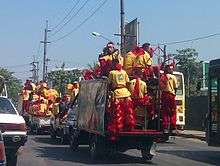
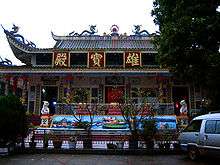
Language
Most Burmese Chinese speak Burmese in their daily life. Those with higher education also speak Mandarin and/or English. The use of Chinese dialects still prevails. Hokkien (a dialect of Min Nan) and Taishanese (a Yue dialect akin to Cantonese) are mostly used in Yangon as well as in Lower Myanmar, while Yunnanese Mandarin is well preserved in Upper Myanmar.
Although General Ne Win's rule (1962–1988) enacted the ban on Chinese-language schools that caused a decline of Mandarin speakers, the number of Chinese schools is growing again. (Note: Standard Mandarin refers to the national language of Mainland China and Taiwan, distinct from the Southwestern Mandarin dialect of the Upper Myanmar, Kokang and Panthay). At the end of 2012, Mizzima News reported that an increasing number of young Burmese Chinese are expressing interest in Chinese language, taking language courses even when their parents don't understand Chinese. However, this trend is not necessarily indicative of an interest in joining Chinese community or cultural organizations, as many of their parents did. Groups like the Myanmar Overseas Young Chinese League report a lack of interest from Burmese Chinese youth.[95]
Religion
Most Burmese Chinese practice Theravada Buddhism, incorporating some Mahayana Buddhist and Taoist beliefs, such as the worship of Kuan Yin. There are several notable Chinese temples in Yangon, including Fushan Temple (a Buddhist temple), Kheng Hock Keong Temple (a Taoist temple dedicated to Mazu) and Guanyin Gumiao Temple (a Buddhist temple dedicated to Guanyin).
The Panthay or Chinese Muslims (回教華人; ပန်းသေးလူမျိုး, lit. "little flowers") practice Islam.
Names
The Burmese Chinese have Burmese names and many also have Chinese names. Given names in various Chinese dialects are often transliterated into the Burmese language, using phonetic transcriptions or translated. For example, a Burmese Chinese person named 'Khin Aung' may have the Chinese name of 慶豐 (Hokkien POJ: Khèng-hong), with '慶' (Hokkien POJ: khèng) corresponding to 'Khin', and '豐' (Hokkien POJ: hong) corresponding to 'Aung'. However, variations of transcription do exist (between dialects), and some Burmese Chinese do not choose to adopt similar-sounding Burmese and Chinese names. Because the Burmese lack surnames, many Burmese Chinese tend to pass on portions of their given names to future generations, for the purpose of denoting lineage.
According to publications of Long Shan Tang, a clan association based in Yangon, the ten most common Chinese surnames in Yangon are:
Cuisine
 |
| Chinese cuisine |
|---|
|
|
Overseas cuisine |
|
Ingredients and types of food |
|
Burmese Chinese cuisine is based on Chinese cuisine, particularly from Fujian, Guangdong and Yunnan provinces, with local influences. Spices such as turmeric and chili are commonly used. Also, the use of soy sauce, bean curd, bean sprouts, Chinese pickled mustards, and dried mushrooms can be attributed to Chinese influence. The following is a partial list of Chinese contributions to Burmese cuisine. These are an established part of today's Burmese cuisine, and are hardly differentiated as a foreign cuisine.
- Pauksi: steamed buns
- Bèkin: roasted duck
- Igyakway: fried Chinese doughnut
- Htamin kyaw: fried rice
- La mont: mooncake
- Mi shay: thin rice noodle soup
- Mi swan: thin wheat noodles
- San byoke: rice porridge
- Panthay khauk swè: Panthay-style fried noodles
- Sigyet khaukswè: literally "noodles laced in cooked oil," usually with chicken
- kyay o: literally "beehoon soup with chicken or pork,"
History
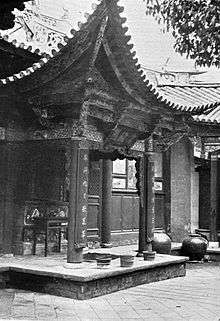
Pre-colonial era
The earliest records of Chinese migration into present-day Myanmar were in the Song and Ming dynasties.[20] In the 18th century, Ming Dynasty princes settled in Kokang (the northern part of present-day Myanmar). Chinese traders, however, traveled as far as the capital city as well as northern towns on the Irrawaddy such as Bhamo. Some of them stayed and started a Chinese community at Amarapura, and when King Mindon moved his capital to Mandalay in 1859, the Chinese were the only community that decided to stay behind. Many of their descendants intermarried into the host society and remain important and respected citizens of Amarapura.
Colonial period
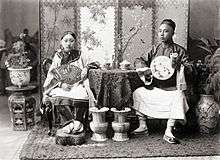
Another wave of immigration occurred in the 19th century under the British colonial administration. Britain encouraged immigration of Indians and Chinese to British Burma, and such incentives for work opportunities and enterprise and for accumulating wealth attracted many Chinese. They primarily came to Burma via British Malaya.[20] The Chinese quickly became dominant in the highly lucrative rice and gem industries. Many became merchants and traders owning both wholesale and retail businesses. Unlike in British Malaya, where most Chinese were coolie laborers, the Chinese in Burma were largely from the artisan and merchant classes.[23] Their success was reflected in the popular Burmese adage, "Earn like the Chinese, save like the Indian, and don't waste money like the Bamar." (ငွေကို တရုတ်လိုရှာ၊ ကုလားလိုစု၊ ဗမာလို မဖြုန်းနဲ့)
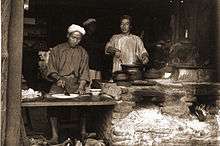
They integrated well into Burmese society not least because they, like the Bamar, were of Sino-Tibetan stock and were Buddhists, implicit in the nickname pauk hpaw (ပေါက်ဖော်, lit. "sibling").[96] During British rule, marriage between the Chinese and Burmese, particularly Chinese men and Burmese women, was the most common form of intermarriage in Burma, as evidenced by a High Court ruling on the legal status of Sino-Burmese marriages under Burmese Buddhist law.[97]
The Chinese are arguably the only other group of people, apart from the Hindu Indians, the ethnic Bamar historically have a high regard for, not just for their ancient and uninterrupted civilization but for their skills and intellect as well. From 1935 until the end of British rule, the Chinese were represented in the colonial legislature, the House of Representatives.[98]
After World War II, displaced Burmese Chinese (whose pre-war homes were in Burma), were the most numerous group of overseas Chinese in Southeast Asia to request repatriation to return to Burma, according to the United Nations Relief and Rehabilitation Administration.[99]
Post-independence era
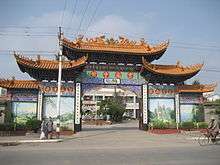
During the 1950s, Burma was one of the first countries to recognize the People's Republic of China as a nation. However, its own Chinese population was treated as aliens. The Burmese Chinese were issued foreign registration cards (FRC) in a tiered citizenship system adopted by the post-independence government. When the Chinese Communists expelled the Kuomintang, many fled to Burma and Thailand over the borders of Yunnan Province. The Burmese government fought and removed the armed KMT and forced them to Taiwan;[100] those who managed to stay prospered. In the 1950s, discriminatory policies against overseas Chinese encompassed citizenship, government employment, approval for business regulations and licensing, loan extensions and permission to make remittances.[101]
In 1952, Kheng Hock Keong Temple publications estimated that ethnic Chinese, who lived in enclaves in the area along Sinohdan, Latha, and Maung Khaing Streets (with Cantonese typically living above Maha Bandula Road and Hokkiens living below), constituted 9.5% of Rangoon's population.[102] During this period, there was a sharp rise in the number of private Chinese language schools, primarily teaching Mandarin, in Burma, from 65 in 1935 to 259 in 1953 and 259 at its peak in 1962, with many such schools affiliated to the Chinese nationalist (တရုတ်ဖြူ, lit. "White Chinese") or communist (တရုတ်နီ, lit. "Red Chinese") movements.[103] However, fewer than 10% of Burmese Chinese of school age attended Chinese language schools.[104] Similarly, about 80 clan associations operated in the 1950s.
Socialist rule
In 1962, Ne Win led the Socialist coup d'état, establishing the Revolutionary Council under the Burmese Way to Socialism. In February 1963, the Enterprise Nationalization Law was passed, effectively nationalizing all major industries and prohibiting the formation of new factories. This law adversely affected many industrialists and entrepreneurs, especially those without the full citizenship.[105] The government's economic nationalization program further prohibited foreigners, including the non-citizen Chinese, from owning land, sending remittances, getting business licenses and practicing medicine.[106] Such policies led to the beginnings of a major exodus of Burmese Chinese to other countries—some 100,000 Chinese left Burma.[100]
Although a kabya himself, Ne Win banned Chinese-language education and created other measures to compel the Chinese to leave. Ne Win's government stoked up racial animosity and ethnic conflicts against the Chinese, who were terrorized by Burmese citizens, the most violent riots taking place at the time of the Cultural Revolution in China in 1967.[100] All schools were nationalized, including Chinese language schools. Beginning in 1967 and continuing throughout the 1970s, anti-Chinese riots continued to flare up and many believed they were covertly supported by the government.[107] Similarly, Chinese shops were looted and set on fire. Public attention was successfully diverted by Ne Win from the uncontrollable inflation, scarcity of consumer items and rising prices of rice. The 1982 Citizenship Law further restricted Burmese citizenship for Burmese Chinese (as it stratified citizenship into three categories: full, associate, and naturalized) and severely limited Burmese Chinese, especially those without full citizenship and those holding FRCs, from attending professional tertiary schools, including medical, engineering, agricultural and economics institutions.[20] During this period, the country's failing economy and widespread discrimination accelerated an emigration of Burmese Chinese out of Burma.
Modern era
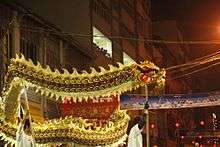
In 1988, the State Law and Order Restoration Council (SLORC) came to power, and gradually loosened the government's role in the economy, encouraging private sector growth and foreign investment. This liberalization of state's role in the economy, if slight and uneven, nonetheless gave the ethnic Chinese-led businesses extra space to expand and reassert their economic power. Today, the majority of retail, wholesale and import trade businesses are run by the Burmese Chinese today.[20] For example, Sein Gayha (စိန်ဂေဟာ), a major retailer that began in Yangon's Chinatown in 1985, is owned by a Hakka Chinese family. Moreover, four of the five largest commercial banks in Myanmar, Myanmar Universal Bank, Yoma Bank, Myanmar Mayflower Bank, and the Asia Wealth Bank, were all founded by Sino-Burmese.[46]
Today, the majority of Burmese Chinese live in the major cities of Yangon, Mandalay, Taunggyi, Bago, and their surrounding areas. Although there are Chinatowns (တရုတ်တန်း; tayoke tan) in the major cities, the Chinese are widely dispersed throughout the country. The northern region of Myanmar has seen a recent influx of mainland Chinese migrant workers, black market traders and gamblers. In Kachin State, which borders China in three directions, Standard Mandarin is the lingua franca.
Upper Myanmar has seen a demographic shift resulting from the recent immigration of many Mainland Chinese to Mandalay Region, Shan,[108] and Kachin States.[109] Ethnic Chinese now constitute an estimated 30 to 40% of Mandalay's population.[110] Huge swaths of land in city centre left vacant by the fires were later purchased, mostly by the ethnic Chinese, many of whom were recent immigrants from Yunnan.[111] The Chinese influx accelerated after the current military government came to power in 1988. With the Burmese government turning a blind eye, many Chinese immigrants from Yunnan (and also from Sichuan) poured into Upper Myanmar in the 1990s, settling in Mandalay.[42] In the 1990s alone, about 250,000 to 300,000 Yunnanese were estimated to have migrated to Mandalay.[110] Their arrival has been vital in the doubling of Mandalay's population from about 500,000 in 1980 to one million in 2008. Chinese festivals are now firmly embedded in the city's cultural calendar.[111] The strong influx of Mainland Chinese immigrants into Mandalay coupled with the presence of strong Chinese economic clout resulted the subsequent displacement of indigenous Burmese to the outskirts of the city creating racial tensions between the two communities.[36]
There are also substantial Burmese Chinese communities outside of Myanmar, particularly in Taiwan, Macau, Hong Kong, Singapore, United States (such as New York City's Henry Street[112]) and Australia.[20][113][114] Zhonghe District, near Taipei, Taiwan is home to 40,000 Burmese Chinese (2008), one of the largest communities outside of Myanmar.[115]
Notable Burmese Chinese
See also
- China–Myanmar relations
- Kuomintang in Myanmar
- Kokang people
- Panlong Subtownship
Further reading
- Mya Than (1997). "The Ethnic Chinese in Myanmar and their Identity". In Leo Suryadinata (ed.). Ethnic Chinese as Southeast Asians. Singapore: Institute of Southeast Asian Studies. ISBN 981-3055-58-8.
References
- "CIA - The World Factbook". Cia.gov. Retrieved 2012-05-11.
- "Burma". State.gov. 2011-08-03. Retrieved 2012-05-11.
- Hooker, Michael Barry (2002). Law and the Chinese in Southeast Asia. Institute of SoutheastAsian Studies. ISBN 981-230-125-9.
- Rieffel, Lex (2010). Myanmar/Burma: inside challenges, outside interests. Brookings Institution Press. pp. 95–97. ISBN 978-0-8157-0505-5.
- "China's Ambitions in Myanmar". July 2000.
- Egreteau, Renaud; Jagan, Larry (2013). Soldiers and Diplomacy in Burma: Explaining the Foreign Relations of the Burmese Praetorian State. Singapore: NUS Press. pp. 271–273. doi:10.2307/j.ctv1nthzz. ISBN 9789971696856.
- Tipton, Frank B. (2008). Asian Firms: History, Institutions and Management. Edward Elgar Publishing. p. 277. ISBN 978-1847205148.
- Santasombat, Yos (2017). Chinese Capitalism in Southeast Asia: Cultures and Practices. Palgrave Macmillan. p. 234. ISBN 978-9811046957.
- Chaturvedi, Medha. "Indian Migrants in Myanmar: Emerging Trends and Challenges" (PDF). Ministry of Overseas Indian Affairs. p. 35.
- Perlez, Jane (November 27, 2016). "Animosity in a Burmese Hub Deepens as Chinese Get Richer". The New York Times. The New York Times. Missing or empty
|url=(help) - "China's Future Role in Burma". Irrawaddy.org. Archived from the original on 2012-03-14. Retrieved 2012-05-11.
- Chua, Amy (May 2004). "Review: The Ethnic Question in Law and Development". World on Fire: How Exporting Free Market Democracy Breeds Ethnic Hatred and Global Instability. The Michigan Law Review Association. 102 (6): 1044–1103. JSTOR 4141938.
- Win, Htet (July 2004). "The Road To Riches?". The Irrawaddy. Archived from the original on 2010-10-06. Retrieved 2006-06-05.
- Sarah Birke (July 3, 2010). "Ethnic tensions grow in Myanmar". The National. Retrieved September 12, 2012.
- Chaturvedi, Medha. "Indian Migrants in Myanmar: Emerging Trends and Challenges" (PDF). Ministry of Overseas Indian Affairs.
- 教育部重編國語辭典修訂本 (in Chinese). Retrieved 8 October 2019.
字詞【突厥】 注音 ㄊㄨˊ ㄐㄩㄝˊ 漢語拼音 tú jué
- Yian, Goh Geok (2009). "The question of 'China' in Burmese chronicles". Journal of Southeast Asian Studies. National University of Singapore. 41 (1): 125–152. doi:10.1017/s0022463409990282.
- Shorto, H.L. (1962). Dictionary of Modern Spoken Mon. Oxford University Press.
- Sao Tern Moeng (1995). Shan-English Dictionary. ISBN 0-931745-92-6.
- Mya Than (1997). Leo Suryadinata (ed.). Ethnic Chinese As Southeast Asians. ISBN 0-312-17576-0.
- Chen, Yi-Sein (1966). "The Chinese in Rangoon during the 18th and 19th Centuries". Essays Offered to G. H. Luce by His Colleagues and Friends in Honour of His Seventy-Fifth Birthday. Volume 1: Papers on Asian History, Religion, Languages, Literature, Music Folklore, and Anthropology. Artibus Asiae Publishers. 23: 107–111. JSTOR 1522640.
- Suryadinata, Leo (2 June 1997). Ethnic Chinese as Southeast Asians. Institute of Southeast Asian Studies. ISBN 9789813055506 – via Google Books.
- Stamp, L. Dudley (January 1930). "Burma: An Undeveloped Monsoon Country". Geographical Review. American Geographical Society. 20 (1): 107–109. doi:10.2307/209128. JSTOR 209128.
- "Mandalay Featured". Mandalay. Realfoodchicago. Retrieved September 12, 2012.
- Hsin-chun Tasaw Lu (2008). "Negotiating Ethnicity: Burmese Chinese Migrants in Taiwan". Journal of Burma Studies. 12: 29–62. doi:10.1353/jbs.2008.0001.
- Gandhi, L. (25 November 2013). "A History Of Indentured Labor Gives 'Coolie' Its Sting". NPR. Retrieved 3 May 2017.
Coolie...quickly became synonymous with the thousands of East and South Asians that traveled to the Americas as part of a system of indentured labor used throughout the British colonies.
- Percival, Bronson (2007). The Dragon Looks South: China and Southeast Asia in the New Century. Praeger (published June 1, 2007). p. 40. ISBN 978-9780978990.
- Chua, Amy (2003). World On Fire. Knopf Doubleday Publishing. pp. 6, 25. ISBN 978-0385721868.
- Gilmour, Karen; Humphries, Anne-Marie; Stonehouse, Phillip (1997). The New ASEANs: Vietnam, Burma, Cambodia & Laos. Department Of Foreign Affairs And Trade. p. 135. ISBN 978-0642271488.
- Santasombat, Yos (2017). Chinese Capitalism in Southeast Asia: Cultures and Practices. Palgrave Macmillan. p. 237. ISBN 978-9811046957.
- Tong, Chee Kiong (2014). Identity and Ethnic Relations in Southeast Asia: Racializing Chineseness. Springer. p. 155. ISBN 978-9400795181.
- Egreteau, Renaud; Jagan, Larry (2013). Soldiers and Diplomacy in Burma: Understanding The Foreign Relations Of The Burmese Praetorian State. National University of Singapore Press. p. 264. ISBN 978-9971696733.
- Chua, Amy (2003). World On Fire. Knopf Doubleday Publishing. pp. 23–25. ISBN 978-0385721868.
- Chua, Amy (2003). World On Fire. Knopf Doubleday Publishing. pp. 30–31. ISBN 978-0385721868.
- Chua, Amy (2003). World On Fire. Knopf Doubleday Publishing. pp. 6–7. ISBN 978-0385721868.
- Kyi Wai (8 July 2011). "Dangerous Anti-Chinese Discontent Growing in Mandalay". The Irrawaddy. Archived from the original on 22 July 2011. Retrieved 25 July 2011.
- Chua, Amy (2003). World On Fire. Knopf Doubleday Publishing. pp. 25. ISBN 978-0385721868.
- Chua, Amy (2003). World On Fire. Knopf Doubleday Publishing. pp. 27. ISBN 978-0385721868.
- Chua, Amy (2003). World On Fire. Knopf Doubleday Publishing. pp. 38. ISBN 978-0385721868.
- Chua, Amy (2003). World On Fire. Knopf Doubleday Publishing. pp. 24–25. ISBN 978-0385721868.
- "China's Ambitions in Myanmar". IISS Strategic Comments. July 2000.
- Stephen Mansfield (1999-05-13). "Myanmar's Chinese connection". Japan Times.
- Chua, Amy (2003). World On Fire. Knopf Doubleday Publishing. pp. 24. ISBN 978-0385721868.
- Slezkine, Yuri (2004). The Jewish Century. Princeton University Press. p. 33.
- Richter, Frank-Jürgen (2 June 1999). Business Networks in Asia: Promises, Doubts, and Perspectives. Greenwood Publishing Group. ISBN 9781567203028 – via Google Books.
- Turnell, Sean (2009). Fiery dragons: banks, moneylenders and microfinance in Burma. NIAS Press. p. 261. ISBN 978-87-7694-040-9.
- Richter, Frank (1999). Business Networks in Asia: Promises, Doubts, and Perspectives. Praeger (published May 30, 1999). p. 198. ISBN 978-1567203028.
- Becker, Jasper (2007). Dragon Rising: An Inside Look at China Today. National Geographic Press. pp. 228–229. ISBN 978-1426201165.
- Miller, Tom (2017). China's Asian Dream: Empire Building along the New Silk Road. Zed Books. ISBN 978-1783609239.
- Maung, Mya (1998). The Burma Road to Capitalism: Economic Growth versus Democracy. Praeger. p. 204. ISBN 978-0275962166.
- Storey, Ian (2013). ASEAN and the Rise of China. Routledge. p. 153. ISBN 978-0415838351.
- Chua, Amy (2003). World On Fire. Knopf Doubleday Publishing. pp. 6. ISBN 978-0385721868.
- Chua, Amy (2003). World On Fire. Knopf Doubleday Publishing. pp. 234. ISBN 978-0385721868.
- Suryadinata, Leo (1997). Ethnic Chinese As Southeast Asians. Institute of Southeast Asian Studies. pp. 144. ISBN 978-9813055506.
- Shannon, Stephanie; Farrelly, Nicholas (April 1, 2014). "Ethnic Chinese in the Midst of Myanmar's Transition" (PDF). Institute of Southeast Asian Studies (19): 6–7. ISSN 2335-6677.
- South, Ashley (2003). Mon Nationalism and Civil War in Burma: The Golden Sheldrake. Routledge (published January 6, 2003). p. 263. ISBN 978-0700716098.
- Wong, Bernard; Tan, Chee-Beng (2017). China's Rise and the Chinese Overseas. Routledge (published August 10, 2017). ISBN 978-1138293687.
- Hays, Jeffrey (June 15, 2015). "Dislike and Distrust of the Chinese in Myanmar". Facts and Details.
- Santasombat, Yos (2015). Impact of China's Rise on the Mekong Region. Palgrave Macmillan. ISBN 978-1349693078.
- Perlez, Jane. "Animosity in a Burmese Hub Deepens as Chinese Get Richer". The New York Times.
- Brown, Ian (2013). Burma's Economy in the Twentieth Century. Cambridge University Press (published November 7, 2013). p. 205. ISBN 978-1107680050.
- Kurlantzick, Joshua (2008). Charm Offensive: How China's Soft Power Is Transforming the World. A New Republic Book. Yale University Press (published May 27, 2008). p. 105. ISBN 978-0300136289.
- Shannon, Stephanie; Farrelly, Nicholas (April 1, 2014). "Ethnic Chinese in the Midst of Myanmar's Transition" (PDF). Institute of Southeast Asian Studies (19): 7. ISSN 2335-6677.
- Reeves, Jeffrey (2015). Chinese Foreign Relations with Weak Peripheral States: Asymmetrical Economic Power and Insecurity. Asian Security Studies. Routledge (published November 2, 2015). ISBN 978-1138891500.
- Chua, Amy (2003). World On Fire. Knopf Doubleday Publishing. pp. 29. ISBN 978-0385721868.
- Chua, Amy (2003). World On Fire. Knopf Doubleday Publishing. pp. 30. ISBN 978-0385721868.
- Steinberg, David (2013). Burma/Myanmar: What Everyone Needs to Know (2nd ed.). Oxford University Press (published June 12, 2013). ISBN 978-0199981687.
- Rotberg, Robert (1998). Burma: Prospects for a Democratic Future. Brookings Institution Press (published June 1, 1998). p. 72. ISBN 978-0815775812.
- Santasombat, Yos (2017). Chinese Capitalism in Southeast Asia: Cultures and Practices. Palgrave Macmillan. pp. 234–236. ISBN 978-9811046957.
- ), Geological Survey (U S. (1 October 2011). Minerals Yearbook: Area Reports: International 2009: Asia and the Pacific. Government Printing Office. ISBN 9781411329744 – via Google Books.CS1 maint: numeric names: authors list (link)
- Joshua Kurlantzich (May 10, 2006). "Treading carefully on the road to Mandalay". Taipei Times. Retrieved September 12, 2012.
- NA, NA (15 September 1997). Ethnic Chinese As Southeast Asians. Palgrave Macmillan. ISBN 9780312175764 – via Google Books.
- Sandhu, K. S.; Mani, A. (2 June 2018). Indian Communities in Southeast Asia (First Reprint 2006). Institute of Southeast Asian Studies. ISBN 9789812304186 – via Google Books.
- Disaphol Chansiri (2008). The Chinese Émigrés of Thailand in the Twentieth Century. ISBN 9781934043745. Retrieved September 12, 2012.
- Chua, Amy (2003). World On Fire. Knopf Doubleday Publishing. pp. 182. ISBN 978-0385721868.
- Chua, Amy (2003). World On Fire. Knopf Doubleday Publishing. pp. 42. ISBN 978-0385721868.
- "Why are Chinese entrepreneurs successful". February 22, 2010.
- Chang, Wen-chin; Tagliacozzo, Eric (April 13, 2011). Chinese Circulations: Capital, Commodities, and Networks in Southeast Asia. Duke University Press. pp. 215–216. ISBN 978-0822349037.
- Chua, Amy (2003). World On Fire. Knopf Doubleday Publishing. pp. 28. ISBN 978-0385721868.
- "Burmese, Chinese traders fight in Mandalay". 27 June 2011. Archived from the original on 1 July 2011. Retrieved September 12, 2012.
- Egreteau, Renaud; Jagan, Larry (2013). Soldiers and Diplomacy in Burma: Understanding The Foreign Relations Of The Burmese Praetorian State. National University of Singapore Press. p. 265. ISBN 978-9971696733.
- Chua, Amy. "Sample text for World on fire : how exporting free market democracy breeds ethnic hatred and global instability / Amy Chua". Library of Congress.
- "Tracking the Tycoons". The Irrawaddy, September 2008 - Vol.16 No.9. Archived from the original on 2010-09-20. Retrieved 2009-01-10.
- Han Oo Khin (March 9–15, 2009). "New era for football". The Myanmar Times. Archived from the original on 2012-02-15.
- Becker, Jasper (2007). Dragon Rising: An Inside Look at China Today. National Geographic Press. pp. 228–229. ISBN 978-1426201165.
- Chua, Amy. "Excerpt: World on Fire". Penguin Random House.
- Kettell, Collin (July 7, 2015). "Robert Kiyosaki: Biggest Stock Market Crash in History Coming in 2016". Kitco.
- "China pipelines bring benefits, complaints". Asia Pacific News Network. May 6, 2012. Retrieved September 12, 2012.
- Santasombat, Yos (2017). Chinese Capitalism in Southeast Asia: Cultures and Practices. Palgrave Macmillan. pp. 234–235. ISBN 978-9811046957.
- Kyi Wai (8 July 2011). "Dangerous Anti-Chinese Discontent Growing in Mandalay". The Irrawaddy. Archived from the original on 22 July 2011. Retrieved 25 July 2011.
- Chua, Amy. "World on Fire" (PDF). Archived from the original (PDF) on 2013-08-25.
- "Location, location, location: Myanmar's the hot new neighborhood". Reuters. January 30, 2012. Retrieved September 12, 2012.
- Chua, Amy (2003). World On Fire. Knopf Doubleday Publishing. pp. 29–31. ISBN 978-0385721868.
- Chua, Amy (2003). World On Fire. Knopf Doubleday Publishing. pp. 238. ISBN 978-0385721868.
- Peng, Qinqin (2012-12-31). "A new generation of Burmese-Chinese". Mizzima News. Archived from the original on 2013-01-03. Retrieved 2013-01-03.
- Aung, Pho Thar (2003-09-16). "Tango with China". The Irrawaddy. Retrieved 2006-06-05.
- Ikeya, Chie (2008). "The Modern Burmese Woman and the Politics of Fashion in Colonial Burma". The Journal of Asian Studies. Cambridge University Press. 67 (4): 1299. doi:10.1017/S0021911808001782.
- Vandenbosch, Amry (February 1947). "The Chinese in Southeast Asia". The Journal of Politics. Cambridge University Press on behalf of the Southern Political Science Association. 9 (2): 89. doi:10.2307/2125860. JSTOR 2125860.
- Greene, Katrine R. C. (February 25, 1948). "Repatriating China's Expatriates". Far Eastern Survey. Institute of Pacific Relations. 17 (4): 44–47. doi:10.2307/3022741. JSTOR 3022741.
- Martin Smith (1991). Burma - Insurgency and the Politics of Ethnicity. London, New Jersey: Zed Books. pp. 153–154, 225–226, 98, 39.
- Holmes, Robert A. (1967). "Burmese Domestic Policy: The Politics of Burmanization". Asian Survey. University of California Press. 7 (3): 188–197. doi:10.1525/as.1967.7.3.01p0257y. JSTOR 2642237.
- Lu, Hsin-chun Tasaw (Summer–Fall 2011). "Performativity of Difference: Mapping Public Soundscapes and Performing Nostalgia among Burmese Chinese in Central Rangoon". Asian Music. 42 (2): 19–55. doi:10.1353/amu.2011.0017.
- Murray, Douglas P. (October–December 1964). "Chinese Education in South-East Asia". The China Quarterly. Cambridge University Press on behalf of the School of Oriental and African Studies (20): 78–80. JSTOR 651712.
- Murray (1964), p. 80.
- Holmes (1967), p. 190.
- Holmes (1967), p. 191.
- Steinberg, David L. (2002). Burma: The State of Myanmar. Georgetown University Press. ISBN 0-87840-893-2.
- Sai Zom Hseng (18 April 2011). "Wa People Rely on Chinese Wages for Survival". The Irrawaddy. Archived from the original on 4 October 2011. Retrieved 25 July 2011.
- Wai Moe (15 June 2011). "Instability Beckons in Wake of Kachin Conflict". The Irrawaddy. Archived from the original on 18 August 2011. Retrieved 25 July 2011.
- Poon Kim Shee (2002). "The Political Economy of China–Myanmar Relations: Strategic and Economic Dimensions" (PDF). Ritsumeikan Annual Review of International Studies. Ritsumeikan University. Archived from the original (PDF) on 2016-03-04. Retrieved 2011-07-25.
- Min Lwin (April 2009). "The Chinese Road to Mandalay". The Irrawaddy.
- Maffi, Mario (1994). Gateway to the promised land: ethnic cultures on New York's Lower East Side. Rodopi. p. 22. ISBN 978-90-5183-677-6.
- Richter, Frank-Jürgen (1999). Business networks in Asia: promises, doubts, and perspectives. Greenwood Publishing Group. p. 186. ISBN 978-1-56720-302-8.
- Kathleen Nadeau; Jonathan H. X. Lee; Kathleen M. Nadeau, eds. (2010). Encyclopedia of Asian American Folklore and Folklife. ABC-CLIO. p. 56. ISBN 978-0-313-35066-5.
- Lu, Hsin-chun Tasaw (2008). "Festivalizing Thingyan, Negotiating Ethnicity: Burmese Chinese Migrants in Taiwan". Journal of Burma Studies. 12: 30. doi:10.1353/jbs.2008.0001.
